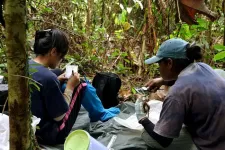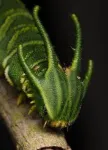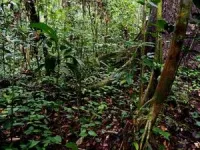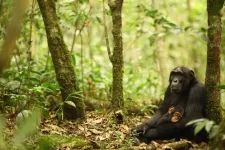(Press-News.org) A research team led by the University of Oxford has carried out the most comprehensive assessment to date of how logging and conversion to oil palm plantations affect tropical forest ecosystems. The results demonstrate that logging and conversion have significantly different and cumulative environmental impacts. The results have been published today (10 January) in Science.
Understanding how different aspects of tropical forests are affected by logging and conversion to oil palm plantations is important for identifying priority habitats for conservation and restoration. It can also help aid decisions on land use – for instance, whether a logged forest should be protected, restored, or allowed to be converted into a plantation. But up to now, most studies have focused on a limited number of factors, making the overall impact on the whole ecosystem difficult to assess.
In this new study, the researchers looked at over 80 metrics describing multiple aspects of the structure, biodiversity, and functioning of the tropical forest ecosystem – from soil nutrients and carbon storage, to photosynthesis rates and numbers of bird and bat species. These were measured in study sites in three areas of Sabah, Malaysian Borneo that were either in undisturbed old growth forest, logged forest (moderately or heavily logged), or in previous logged forests that had been converted to oil palm plantation.
The research, unprecedented in investigating such a broad spectrum of indicators for the health of tropical forest ecosystems in a single analysis, was made possible due to the wide range of study sites established and maintained by the South East Asia Rainforest Research Partnership. In total, logging and conversion had widespread impacts, affecting most of the measured properties - 60 of the 82 ecosystem metrics. However, there were clear differences between the two.
In general, logging mostly impacted factors associated with forest structure and environment. Since logging in the tropics is generally selective - focusing on trees with particular commercial qualities - even low levels of logging alter the system. For example, when older, larger trees are removed, this creates gaps in the canopy, enabling rapid-growing species to emerge that have very different characteristics, including less dense wood and thinner leaves that are more vulnerable to herbivores.
Converting these logged forests to oil palm plantations, however, has greater impacts on biodiversity that go beyond those of logging alone. Species of birds, bats, dung beetles, trees, vines, and soil microorganisms all showed greater reductions in abundance and diversity on plantations compared with logged forests. This is likely due in part to the major changes in plant food resources and the shift to hotter and drier microclimates under the single layer of oil palm that follows conversion from logged forest.
Senior author Professor Andrew Hector (Department of Biology, University of Oxford), said: "One of the key messages of the study is that selective logging and conversion differ in how they impact the forest ecosystem meaning that conversion to plantations brings new impacts that add to those of logging alone."
According to the study team, this demonstrates that logged forest can still be valuable for maintaining biodiversity and should not be immediately ‘written off’ for conversion to oil palm plantations.
Professor Ed Turner (University of Cambridge), who co-led the study, said: "A key message of this work is that old growth, intact forests are unique, but secondary logged forests are also valuable and important in terms of their biodiversity and ecosystem functioning relative to the much-reduced levels seen in oil palm plantations."
One surprise for the research team was how variable the responses were. Dr Charlie Marsh (Department of Biology, University of Oxford at the time of the study, now National University of Singapore), lead author of the study, said: "Our study demonstrates that focussing on any single component of the ecosystem may lead to incomplete understanding of how the ecosystem responds as a whole. We were really surprised by the huge variability in how different facets of the ecosystem responded to deforestation. We saw increases, decreases, or sometimes no change at all. There were even aspects that would increase in logged forest, only to decrease in oil palm plantations. When making decisions concerning land management and conservation, we must consider a broad suite of ecological properties."
Notes to editors:
For interviews and media requests, contact:
Professor Andrew Hector: andrew.hector@biology.ox.ac.uk
and
Dr Charlie Marsh: charlie.marsh@mailbox.org
Images relating to this release that can be used in articles can be found here: https://drive.google.com/drive/folders/1o8RwUj5eQOujjswWVrAbe95g-uJT8_Rv?usp=sharing
These are for editorial purposes relating to this press release ONLY and MUST BE credited. They MUST NOT be sold on to third parties.
The study ‘Tropical forest clearance impacts biodiversity and function whereas logging changes structure’ will be published in Science on 19:00 GMT / 14:00 ET Thursday 9 January 2025, DOI: 10.1126/science.adf9856. Advance copies of the paper may be obtained from the Science press package, SciPak, at https://www.eurekalert.org/press/scipak/ or by contacting scipak@aaas.org
The South East Asia Rainforest Research Partnership:
The study sites and research in Sabah was facilitated by the South East Asia Rainforest Research Partnership (https://www.searrp.org): SEARRP was Established by the Royal Society in 1985, and facilitates world-class scientific research that addresses the major environmental issues facing the tropics: plantation development, habitat restoration and climate change. From its base in Borneo’s Danum Valley, SEARRP work in close collaboration with leading international universities and local partners to facilitate research by individual scientists and manage a suite of large-scale field experiments (The Danum Valley ForestGEO plot, the SAFE project and Sabah Biodiversity Experiment).
The Human Modified Tropical Forests programme
The data synthesized in the paper was collected by the Human Modified Tropical Forests thematic programme funded by the UK's Natural Environmental Research Council.
About the University of Oxford:
Oxford University has been placed number 1 in the Times Higher Education World University Rankings for the ninth year running, and number 3 in the QS World Rankings 2024. At the heart of this success are the twin-pillars of our ground-breaking research and innovation and our distinctive educational offer.
Oxford is world-famous for research and teaching excellence and home to some of the most talented people from across the globe. Our work helps the lives of millions, solving real-world problems through a huge network of partnerships and collaborations. The breadth and interdisciplinary nature of our research alongside our personalised approach to teaching sparks imaginative and inventive insights and solutions.
Through its research commercialisation arm, Oxford University Innovation, Oxford is the highest university patent filer in the UK and is ranked first in the UK for university spinouts, having created more than 300 new companies since 1988. Over a third of these companies have been created in the past five years. The university is a catalyst for prosperity in Oxfordshire and the United Kingdom, contributing £15.7 billion to the UK economy in 2018/19, and supports more than 28,000 full time jobs.
The Department of Biology is a University of Oxford department within the Maths, Physical, and Life Sciences Division. It utilises academic strength in a broad range of bioscience disciplines to tackle global challenges such as food security, biodiversity loss, climate change and global pandemics. It also helps to train and equip the biologists of the future through holistic undergraduate and graduate courses. For more information visit www.biology.ox.ac.uk.
END
Don’t write off logged tropical forests – converting to oil palm plantations has even wider effects on ecosystems
2025-01-09
ELSE PRESS RELEASES FROM THIS DATE:
Chimpanzees are genetically adapted to local habitats and infections such as malaria
2025-01-09
Chimpanzees bear genetic adaptations that help them thrive in their different forest and savannah habitats, some of which may protect against malaria, according to a study by an international team led by UCL researchers.
Chimpanzees are our closest living relatives, sharing over 98% of their DNA with humans, and the scientists say that their findings, published in Science, can not only teach us about our own evolutionary history, but also about the biology of malaria infection in humans.
Chimpanzees are endangered ...
Changes to building materials could store carbon dioxide for decades
2025-01-09
Replacing conventional building materials with materials modified to store carbon dioxide could move the planet closer to net-zero greenhouse gas emissions, according to a new study by Elisabeth Van Roijen and colleagues. The researchers calculate that full replacement of conventional building materials with these CO2-sequestering alternatives could store as much as 16.6 ± 2.8 gigatons of CO2 each year – an equivalent to about 50% of the anthropogenic CO2 emissions in 2021. Removing carbon dioxide from the atmosphere, along with decreasing emissions, is important for slowing ...
EPA finalized rule on greenhouse gas emissions by power plants could reduce emissions with limited costs
2025-01-09
In this Policy Forum, John Bistline and colleagues analyze the potential impacts of the U.S. Environmental Protection Agency’s finalized power plant rules regarding greenhouse gas emissions. Using nine models of the U.S. electric sector and energy systems, the researchers found that the rules would speed up the reduction of emissions in the power sector. Under the rules, the levels of carbon dioxide emitted by the sector would be 61%-81% below 2005 levels by 2040. Under current policies, emission levels would be 51% to 83% below 2005 levels by 2040, ...
Kangaroos kept a broad diet through late Pleistocene climate changes
2025-01-09
Samuel Arman and colleagues’ close examination of tooth microwear among living and extinct kangaroo species suggests that most of the species living in Australia during the Late Pleistocene had a broad, generalist diet rather than being specialized grazers. This broad diet likely allowed them to survive the glacial-interglacial cycles that drove fluctuations in vegetation on the continent. The findings add more evidence to the idea that human hunting, rather than failure to adapt to climate changes, ...
Sex-specific neural circuits underlie shifting social preferences for male or female interaction among mice
2025-01-09
Male and female mice both prefer social interaction with female mice under normal conditions, but both switch to preferring males when their survival is threatened, according to a new study by Anqi Wei and colleagues. These preferences are mediated by different neuronal circuitry in male and female mice related to dopaminergic neurons in the brain’s ventral tegmental area, the researchers found. The findings offer a clearer picture of the underlying biology of socio-sexual preferences. These preferences are essential for successful reproduction, ...
The basis of voluntary movements: A groundbreaking study in ‘Science’ reveals the brain mechanisms controlling natural actions
2025-01-09
Eight years of work. A collaboration between the Laboratory of Neuroethology of Non-Human Primates of the Department of Medicine and Surgery of the University of Parma, led by Luca Bonini, and a team from the Biorobotics Institute of the Sant'Anna School of Pisa, coordinated by Alberto Mazzoni, principal investigator at the Computational Neuroengineering Lab, with the contribution of Silvestro Micera, professor in Bioingeneering. Support from three projects funded by the European Research Council (ERC) and as many Italian national projects, including MNESYS and BRIEF. These are just some of the elements of a groundbreaking study published in ...
Storing carbon in buildings could help address climate change
2025-01-09
Construction materials such as concrete and plastic have the potential to lock away billions of tons of carbon dioxide, according to a new study by civil engineers and earth systems scientists at the University of California, Davis and Stanford University. The study, published Jan. 10 in Science, shows that combined with steps to decarbonize the economy, storing CO2 in buildings could help the world achieve goals for reducing greenhouse gas emissions.
“The potential is pretty large,” said Elisabeth Van ...
May the force not be with you: Cell migration doesn't only rely on generating force
2025-01-09
By Beth Miller
In mechanobiology, cells’ forces have been considered fundamental to their enhanced function, including fast migration. But a group of researchers in the McKelvey School of Engineering at Washington University in St. Louis has found that cells can generate and use lower force yet move faster than cells generating and using high forces, turning the age-old assumption of force on its head.
The laboratory of Amit Pathak, professor of mechanical engineering and materials science, found that groups of cells moved faster with lower force when adhered to soft surfaces with aligned collagen fibers. Cells have been thought to continually generate ...
NTU Singapore-led discovery poised to help detect dark matter and pave the way to unravel the universe’s secrets
2025-01-09
Researchers led by Nanyang Technological University, Singapore (NTU Singapore) have developed a breakthrough technique that could lay the foundations for detecting the universe’s “dark matter” and bring scientists closer than before to uncovering the secrets of the cosmos.
The things we can see on Earth and in space – visible matter like rocks and stars – make up only a small portion of the universe, as scientists believe that 85 per cent of matter in the cosmos comprises invisible dark matter. This mysterious substance ...
Researchers use lab data to rewrite equation for deformation, flow of watery glacier ice
2025-01-09
AMES, Iowa – Neal Iverson started with two lessons in ice physics when asked to describe a research paper about glacier ice flow that has just been published by the journal Science.
First, said the distinguished professor emeritus of Iowa State University’s Department of the Earth, Atmosphere, and Climate, there are different types of ice within glaciers. Parts of glaciers are at their pressure-melting temperature and are soft and watery.
That temperate ice is like an ice cube left on a kitchen counter, with meltwater ...







